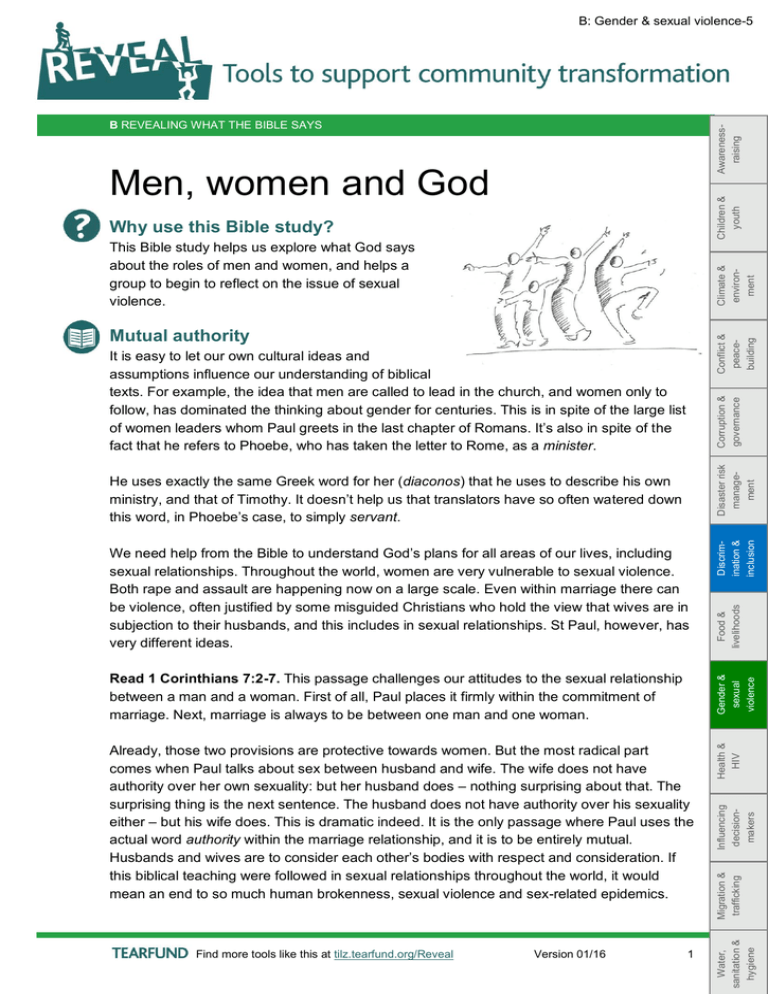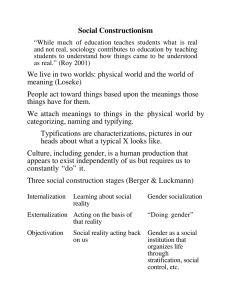
B: Gender & sexual violence-5
Awarenessraising
B REVEALING WHAT THE BIBLE SAYS
Children &
youth
Men, women and God
Why use this Bible study?
Climate &
environment
This Bible study helps us explore what God says
about the roles of men and women, and helps a
group to begin to reflect on the issue of sexual
violence.
Conflict &
peacebuilding
Mutual authority
We need help from the Bible to understand God’s plans for all areas of our lives, including
sexual relationships. Throughout the world, women are very vulnerable to sexual violence.
Both rape and assault are happening now on a large scale. Even within marriage there can
be violence, often justified by some misguided Christians who hold the view that wives are in
subjection to their husbands, and this includes in sexual relationships. St Paul, however, has
very different ideas.
Find more tools like this at tilz.tearfund.org/Reveal
Version 01/16
1
Influencing
decisionmakers
Migration &
trafficking
Water,
sanitation &
hygiene
Already, those two provisions are protective towards women. But the most radical part
comes when Paul talks about sex between husband and wife. The wife does not have
authority over her own sexuality: but her husband does – nothing surprising about that. The
surprising thing is the next sentence. The husband does not have authority over his sexuality
either – but his wife does. This is dramatic indeed. It is the only passage where Paul uses the
actual word authority within the marriage relationship, and it is to be entirely mutual.
Husbands and wives are to consider each other’s bodies with respect and consideration. If
this biblical teaching were followed in sexual relationships throughout the world, it would
mean an end to so much human brokenness, sexual violence and sex-related epidemics.
Health &
HIV
Gender &
sexual
violence
Read 1 Corinthians 7:2-7. This passage challenges our attitudes to the sexual relationship
between a man and a woman. First of all, Paul places it firmly within the commitment of
marriage. Next, marriage is always to be between one man and one woman.
Food &
livelihoods
He uses exactly the same Greek word for her (diaconos) that he uses to describe his own
ministry, and that of Timothy. It doesn’t help us that translators have so often watered down
this word, in Phoebe’s case, to simply servant.
Discrimination &
inclusion
Disaster risk
management
Corruption &
governance
It is easy to let our own cultural ideas and
assumptions influence our understanding of biblical
texts. For example, the idea that men are called to lead in the church, and women only to
follow, has dominated the thinking about gender for centuries. This is in spite of the large list
of women leaders whom Paul greets in the last chapter of Romans. It’s also in spite of the
fact that he refers to Phoebe, who has taken the letter to Rome, as a minister.
B: Gender & sexual violence-5
C MEN, WOMEN AND GOD
Awarenessraising
Key points
We should not get our ideas about women and men’s roles from the culture around us.
The Bible clearly tells us that women and men can both be leaders. It also tells us that
women as well as men both have equal authority over each other’s sexuality.
Children &
youth
Questions for discussion
Climate &
environment
Conflict &
peacebuilding
What does this passage tell us about God’s views on people having more than one sexual
partner?
Why is this biblical view protective towards women?
What happens to the idea of gender inequality in this passage?
What are Paul’s underlying principles in the sexual relationship between husband and
wife?
What stops the worldwide church from living out this vision for men and women?
Corruption &
governance
Reflection
Disaster risk
management
Think about your own personal relationships with people of the opposite gender. How can
you help relationships to be more equal?
Notes
Discrimination &
inclusion
This Bible study was written by Dr. Elaine Storkey and first published in Tearfund (2006) Footsteps 66
– Human rights http://tilz.tearfund.org/en/resources/publications/footsteps/footsteps_6170/footsteps_66/
Food &
livelihoods
Gender &
sexual
violence
Health &
HIV
Influencing
decisionmakers
Related tools
A1 – Revealing violence against women and girls: information for facilitators [A1: Gender &
sexual violence-1]
A2 – Understanding how men and women use their time [A2: Gender & sexual violence-1]
A2 – Exploring men and women’s control over resources [A2: Gender & sexual violence-2]
A2 – Why address violence against women and girls [A2: Gender & sexual violence-3]
A2 – What are the root causes of violence against women and girls? [A2: Gender & sexual
violence-4]
A2 – Exploring gender roles and power [A2: Gender & sexual violence-5]
A2 – Men and women: listening to one another [A2: Gender & sexual violence-6]
A2 – Self-discovery tool (Violence against women and girls) [A2: Gender & sexual violence-7]
B – Gender and restoring relationships (Bible study) [B: Gender & sexual violence-1]
B – God’s view of women (Bible study) [B: Gender & sexual violence-3]
B – God’s view of men (Bible study) [B: Gender & sexual violence-4]
B – Protecting those vulnerable to sexual violence (Bible study) [B: Gender & sexual violence7]
B – Sexual violence in the Bible — the story of Tamar (Bible study) [B: Gender & sexual
violence-8]
Migration &
trafficking
Water,
sanitation &
hygiene
Find more tools like this at tilz.tearfund.org/Reveal
2





